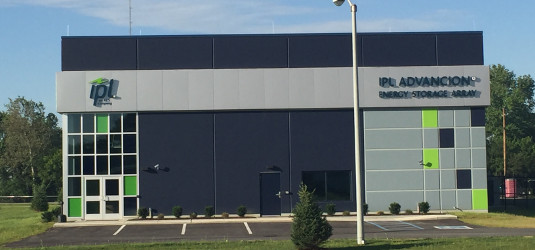The 20 MW battery will provide primary frequency response services and can assist with the integration of solar and wind.
Last Thursday Indianapolis Power and Light (IPL) connected a 20 MW lithium-ion battery to the grid in Indianapolis, Indiana, as the first such large-scale battery to be connected to the transmission grid in the entire Midcontinent Independent System Operator (MISO) grid.
MISO covers 15 U.S. states, mostly in the Midwest and South, as well as the Canadian province of Manitoba.
The announcement of interconnection of the Advancion Array was made at a White House summit on energy storage and renewable energy integration, which saw commitments by the federal government and private companies to install 1.3 GW of batteries and other forms of advanced energy storage to the grid over the next five years.
IPL also says that this will be the first grid-scale battery storage system in the United States to provide primary frequency response services. The system can match supply and demand on an instantaneous basis, which supports the integration of electricity from solar PV and wind.
The Advancion array utilizes AES’ Advancion 4 platform, which utilizes fast-response IGBT power conversion technology and AES software and hardware control aggregation platform. Advancion 4 is a fourth generation design, which IPL says incorporates lessons from the battery systems it has previously deployed.
AES and its Advancion product were recognized last week with utility trade group Edison Electric Institute’s 2016 Edison Award.
IPL has deployed 96 MW of solar PV over the last three years, and according to a report by Environment America, Indianapolis currently has the 2nd-highest amount of per-capita solar PV installed of any major city in the United States.
This is particularly impressive for its location. Most of the solar PV deployed to in the United States to date has been in California, the Southwest and the Northeast, and the Midwest has lagged behind these regions.
As such, despite its high deployment of solar PV, Indianapolis does not face some of the integration issues that California and Hawaii have experienced. The city’s presence in the MISO grid means that it can easily trade electricity at times of high solar output with its neighbors.
This content is protected by copyright and may not be reused. If you want to cooperate with us and would like to reuse some of our content, please contact: editors@pv-magazine.com.









By submitting this form you agree to pv magazine using your data for the purposes of publishing your comment.
Your personal data will only be disclosed or otherwise transmitted to third parties for the purposes of spam filtering or if this is necessary for technical maintenance of the website. Any other transfer to third parties will not take place unless this is justified on the basis of applicable data protection regulations or if pv magazine is legally obliged to do so.
You may revoke this consent at any time with effect for the future, in which case your personal data will be deleted immediately. Otherwise, your data will be deleted if pv magazine has processed your request or the purpose of data storage is fulfilled.
Further information on data privacy can be found in our Data Protection Policy.